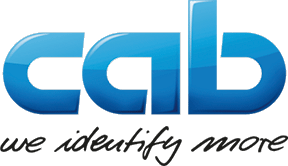What has to be considered when using consumables with a flag applicator, type 4712?
- In general, an increased height and width of the label increases tolerances in the event of the flag created. Therefore, labels with a height of 20-30 mm and a width of 80-100 mm should be favored.
- Altering the label’s position in x-direction (crosswise to the print direction) has direct influence on the quality of the flag created and results in the flag’s lateral overlapping.
- After the label has been created and due to the inherent rigidity of the label material, the flags are opened as a result of the restoring forces. This happens very close to the workpiece – the so-called „heart forming“. Restoring forces of the label material depend, especially for plastic labels, on material and thickness of the label. When applying paper labels this is mainly influenced by the fibrous structure in the label. Usually, applying paper labels is less critical.
- Due to the labels‘ double perforation in print direction and at the positions at which the flag is formed at its outer diameter, the restoring forces can be minimized. However, perforation depending on diameter and influence of positioning tolerances are disadvantageous.
- Less rigid and thin label materials usually turn out to be problematic with regard to their dispensing behavior and when being transferred to the suction plates. As air is sucked through vacuum holes the label will be deformed and may result in the orientation of the label that adversely influences the flag’s forming. Using an extended dispense plate may, if necessary, have a positive influence on the dispensing behavior.
- It is necessary to pay particular attention to the material when applying cables and tubes. Low-energy materials with a high proportion of silicone or PTFE prevent the flag from being glued to the workpiece and must be avoided.
- When applying flowed products it is necessary to pay attention to the operating temperature range of the label and the label adhesive. The same applies to the automotive industry for applications under the hood of vehicles.
- For applications in the automotive industry special attention must be paid to the solvent resistance of label and adhesive (brake fluid, detergents, grease, silicone, benzene, fuel, etc.).
- cab Produkttechnik GmbH & Co KG has a wide range of label material available for the adhesion on high and low-energy surfaces, as for example ABS, PP, PE, polyester, hard PVC, metal, coating and glass. Combined with cab color ribbons a resistance against chemicals as for example acetone, MEK, ethanol, isopropyl, brake fluid DOT4, premium grade petrol or toluene can be guaranteed.
Valid for: Hermes+ Applicators
Last change: 11.08.2017 - 11:16
